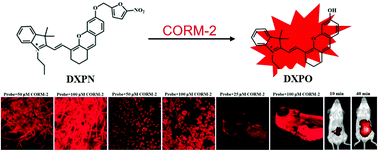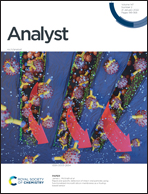A new metal-free near-infrared fluorescent probe based on nitrofuran for the detection and bioimaging of carbon monoxide releasing molecule-2 in vivo†
Abstract
As a stable donor for releasing controlled amounts of CO, carbon monoxide releasing molecule-2 (CORM-2) is a new type of therapeutic drug that contributes to exploring the pathophysiological effects of CO. The accurate detection of CORM-2 in biological systems is of great significance for controlling its dosage as a therapeutic drug and elucidating the reaction mechanisms of CO, but currently there is a lack of metal-free near-infrared fluorescent probes. Herein, a new metal-free near-infrared fluorescent probe based on nitrofuran which could selectively identify CORM-2 was designed and it has been successfully applied in living cells, zebrafish and mice. After reacting with CORM-2, both the color and fluorescence signal of the solution are restored, which is ascribed to the reduction of the nitro group. The spectroscopic probe DXPN shows high sensitivity to CORM-2 with a low detection limit of 87 nM and near-infrared fluorescence emission of 712 nm. Notably, this is the first time that paper chips are being used as a carrier to detect CORM-2 through fluorescence signals instead of the traditional liquid phase detection mode of fluorescent probes. These superior properties of the probe make it a promising and reliable tool for exploring the role played by CORM-2 in biological systems.

- This article is part of the themed collection: Analyst HOT Articles 2021


 Please wait while we load your content...
Please wait while we load your content...